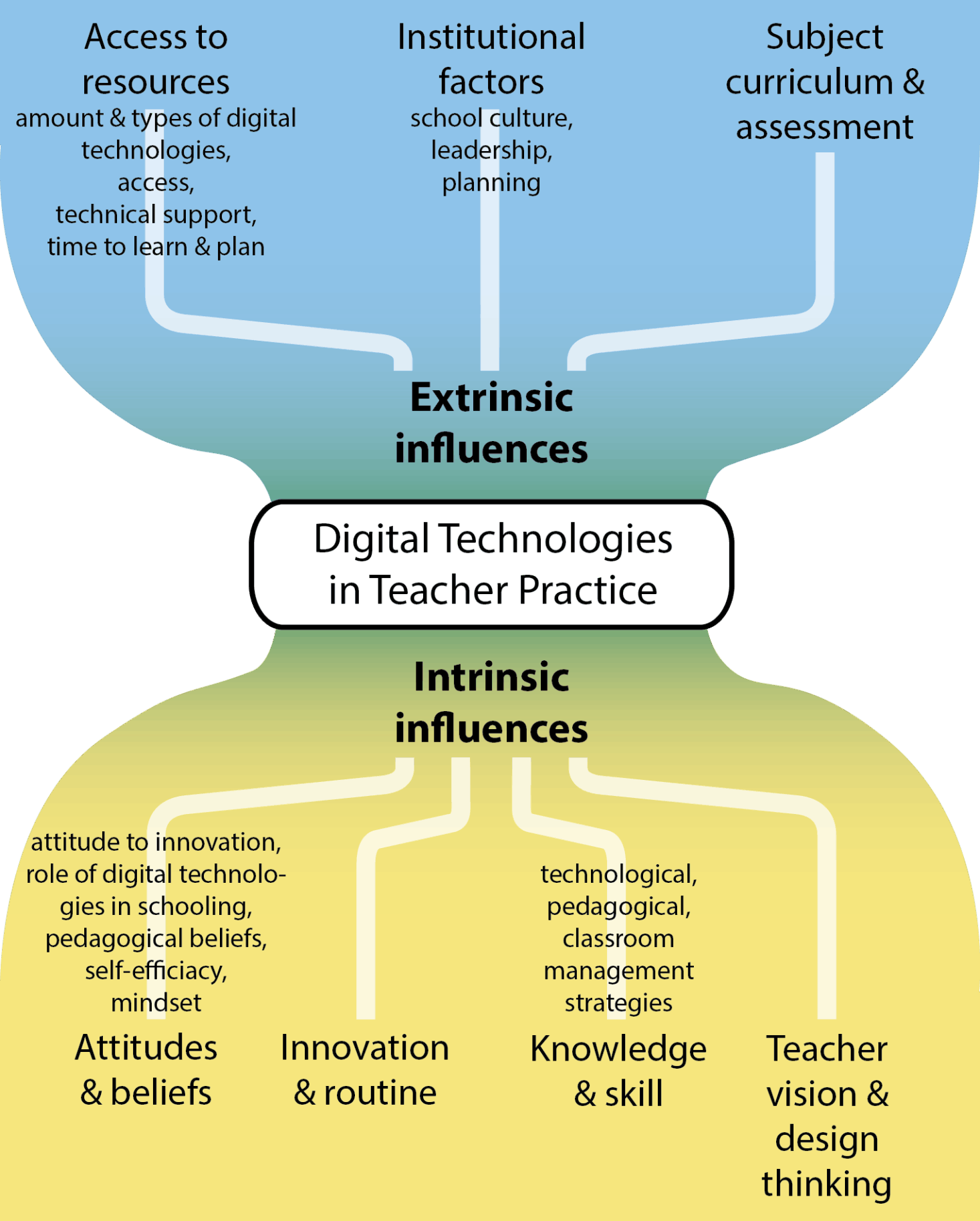

Extrinsic barriers are often called first-order barriers because they must be overcome first. For example, it is challenging to use a digital pedagogy without access to technology. However, the provision of digital technologies does not automatically lead to their use in learning and teaching because teachers must activate digital pedagogy and learning. The challenges associated with intrinsic influences (commonly called second-order barriers) are the "true gatekeepers" to the integration of digital technologies (Ertmer et al., 2012, p. 433).
Teacher practice occurs at the nexus of extrinsic and intrinsic influences. Viewing these influences are barriers is problematic. School-based leaders of innovation -- those people in every school who contribute to improvement of practice, irrespective of their formal roles -- can help to positive shape improvement. The following table includes questions for leaders of innovation seeking to engage with extrinsic and intrinsic influences.
| Group | Influence | Questions for school leaders of innovation |
|---|---|---|
| Extrinsic influences | Access to resources | Do students and teachers have: - ready access to appropriate types technology in the right places? - technical support? Do techers have: - time to learn, review and plan with digital technologies? - professional development, learning and training? |
| Extrinsic influences | Institutional factors | What is the school culture in relation the place of technology in learning and pedagogy? Is this a school priority? How is a shared vision established and cultivated? How are teachers encouraged and recognised for using digital technologies in learning and teaching? Planning technology enabled lessons is (initially) more involved than planning didactic pedagogies and drill lessons. How are teachers supported while they innovate? |
| Extrinsic influences | Subject curriculum and assessment | The policies and procedures of external curriculum and assessment authorities typically define key practices in schooling. Can your teachers identify their personal influence and agency in these systems? How can teachers be supported to find the opportunities within the constraints? What internal school policies and procedures enable innovation in curriculum and assessment with digital technologies? Which internal school policies and procedures are barriers? Can these barriers be resolved? |
| Intrinsic influences | Attitudes and beliefs | How do you encourage your teachers to explore and engage in dialogue about their: - attitudes to innovation? - beliefs about the role of technology in schooling, pedagogy and learning? - sense of personal competence and self-efficacy? - mindsets about learning, including their own? |
| Intrinsic influences | Innovation and routine | How do you encourage innovation? How do you connect early adopters with the rest of your team? How do you: - help teachers to appreciate the power routines to professional practice? - ensure and support each other when reliable routines are disrupted by integrating digital technologies? - support teachers to develop new classroom routines with digital technologies? - cultivate confidence? |
| Intrinsic influences | Knowledge and skill | How do you activate professional learning for: - technological competence? - technological-pedagogical-content knowledge? - positive classroom management strategies that are appropriate to the new dynamic? |
| Intrinsic influences | Teacher’s vision and design thinking | Have you established a shared vision for using digital technologies for learning and teaching? Have you engaged with your teachers' vision for using technology in their professional practice? Many of the challenges that emerge when integrating in learning and teaching are unique to the learning context. How do you help your teachers to identify the opportunities for growth in these challenges? How do you develop your teachers' capacity to design solutions for emergent challenges? |
The importance of positive school culture and growth mindsets can not be understated, particularly when positioning challenges as opportunities for professional learning. Supporting teachers to recognise and conceptualise (Blundell, Lee, & Nykvist, 2016) these influences on their practice provides them with a common language and forms the basis of collaboration towards the resolution of emergent challenges (Blundell, 2017). The driver, as should always be the case, is how do we improve our students' learning opportunities?
References:
Blundell, C.. (2017). A case study of teachers transforming pedagogical practices through collaborative inquiry-based professional learning in a ubiquitous technologies environment. PhD thesis, Queensland University of Technology.
Blundell, C., Lee, K.-T., & Nykvist, S. (2016). Digital Learning in Schools: Conceptualizing the Challenges and Influences on Teacher Practice. Journal of Information Technology Education: Research, 15, 535-560.
Ertmer, P. A. (1999). Addressing first- and second-order barriers to change: Strategies for technology integration. Educational Technology Research and Development, 47(4), 47-61. doi:10.1007/bf02299597
Ertmer, P. A., Ottenbreit-Leftwich, A. T., Sadik, O., Sendurur, E., & Sendurur, P. (2012). Teacher beliefs and technology integration practices: A critical relationship. Computers & Education, 59(2), 423-435.
Published: 17 April, 2018
Copyright 2018 by Christopher Blundell